Module 2: Urinary Catheter Maintenance Facilitator Notes
Preventing CAUTI in the ICU Setting
Slide 1
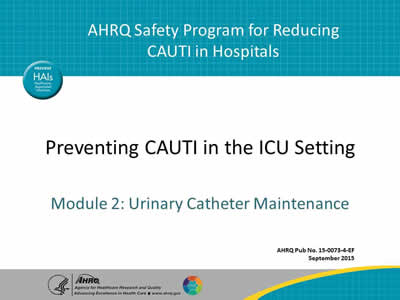
Say:
In Module 1, we discussed the indications for an indwelling urinary catheter, the causes of catheter-associated urinary tract infections or CAUTI in the intensive care unit or ICU, as well as methods to mitigate the risk of CAUTI. In this module, we will use a case scenario to examine ways to prevent CAUTI when a catheter is already in place.
Slide 2
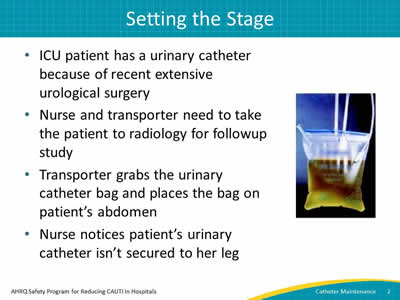 3
3
Say:
This case scenario involves an ICU patient who has a urinary catheter because of recent extensive urological surgery. The nurse and transporter need to take the patient to radiology for a followup study. In preparation for moving the patient from the bed to the cart, the transporter grabs the urinary catheter bag and places the bag on top of the patient’s abdomen. The bag is approximately two-thirds full with urine. The nurse also notices that the patient’s urinary catheter isn’t secured to her leg.
Slide 3

Say:
I recommend that you stop the video and think about this question for a few minutes: What did you notice in the case scenario that could lead to the development of a CAUTI? If it would be helpful, you can go back and listen to the case scenario again before moving on in the presentation.
Slide 4
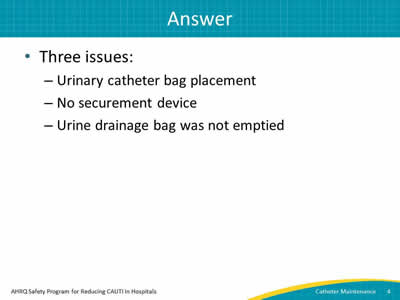
Say:
You should have identified three issues that can lead to the development of a CAUTI:
- The transporter put the urinary catheter drainage bag, which has a measurable amount of urine in it, on top of the patient. This is dangerous because urine could flow back from the bag into the bladder.
- The nurse failed to use a securement device to attach the catheter to the patient’s leg. Not attaching the catheter to the leg can lead to urethral irritation.
- The drainage bag was not emptied. Emptying the drainage bag will help keep the urine from flowing back into the tubing when the patient is moving.
Slide 5
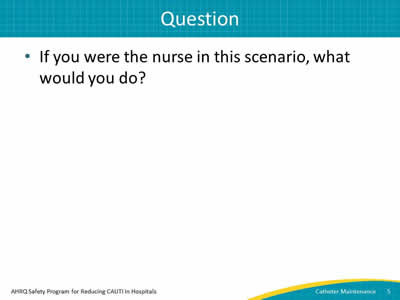
Say:
This leads to another question. Once again, I recommend that you stop the presentation so that you can think about this question: If you were the nurse in this scenario, what would you do?
Slide 6
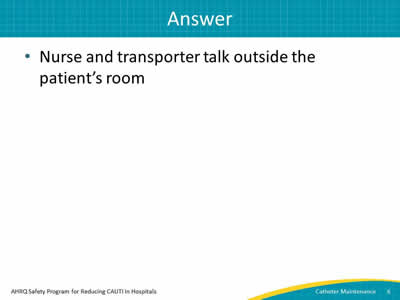
Say:
The worst thing you can do in this case is ignore the problem. The second-worst thing is talking about it in front of the patient. Your best option is to ask the transporter to step outside the room with you so that you can have the difficult but very important conversation about the two points you noticed. The conversation might go something like this:
(Discussion between two males)
Nurse: “Hey, Mike, I wanted to talk with you about something before we move Mrs. Ramirez.”
Transporter: “Sure, what’s up?”
Nurse: “You know that we’ve been trying to decrease our CAUTI rates here, right? Well, how we handle the catheter tubing and bag can make a big difference.”
Transporter: “Did I do something wrong?”
Nurse: “Not exactly. It’s just that when we prepare a patient for transport, it’s important that I empty the patient’s urinary catheter bag before we move him or her. Doing that will help keep the urine from flowing back into the tubing when the patient is moving. It will also help if we keep the bag below the level of the bladder when we move her from the bed to the cart.”
Transporter: “That makes sense. So we shouldn’t put the bag on the patient’s abdomen, because that is above the bladder?”
Nurse: “Yes, you’re correct.”
Transporter: “OK, I got it. Anything else?”
Nurse: “Another thing we can do to help prevent a CAUTI from developing is to find a safe place to hang the bag on the cart. Also, with Mrs. Ramirez, I can show you how I apply a securement device on the tubing and secure it to her leg. With all the moving around, it will prevent irritation of her urethra, which is another potential risk for a CAUTI.”
Transporter: “OK, thanks.”
Slide 7
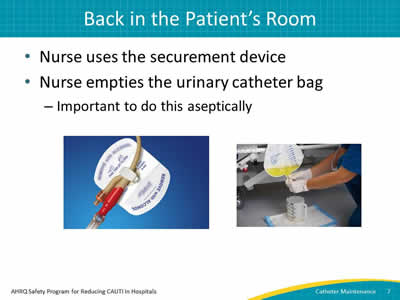
Say:
After having the conversation, the nurse and the transporter go back into the patient’s room. The nurse places the securement device on the patient’s leg, making sure to show the transporter how to use this device.
Next, the nurse empties the urinary catheter bag. Remember, it’s important to do this aseptically by using good hand hygiene practices and avoiding contamination by keeping the spout from touching the sides of the graduated cylinder.
Slide 8
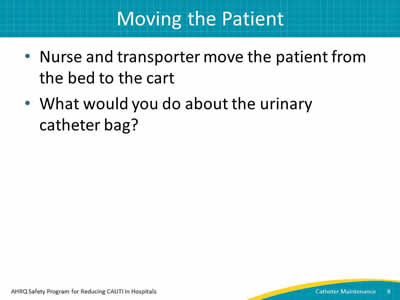
Say:
But the conversation doesn’t end there because the nurse and the transporter still need to do some things once they’ve moved the patient. They will need to continue the important conversation they started.
(Same two male voices)
Nurse: “OK, now we’re ready to transfer her from the bed to the cart.”
Transporter: “I’m making sure the urinary catheter bag is below her bladder. Let’s move her now.”
(Narration resumes)
Together, they move Mrs. Ramirez from the bed to the cart successfully. Although the patient has been moved successfully, what would you do with the urinary catheter bag? I recommend that you pause the presentation briefly to think about this.
That’s right. The nurse should hand the urinary catheter bag to the transporter so he can attach it to the side of the cart, instead of laying it on the patient’s abdomen.
Slide 9
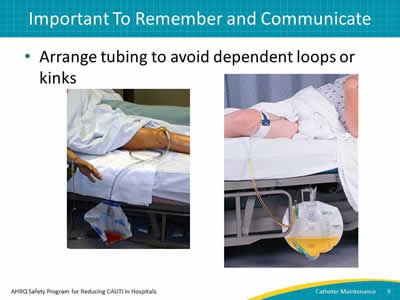
Say:
Although the patient is on the cart, the urinary catheter bag is attached to the side of the cart, and a securement device is in place, the work isn’t quite done. It’s important to arrange the urinary catheter tubing on the cart so it isn’t hanging down in what is called a dependent loop. You can see a loop like that in the picture on the right. A dependent loop would prevent urine from flowing freely. Instead, be sure the tubing looks like the picture on the left side of this slide.
At this point, the patient is ready to go.
Slide 10
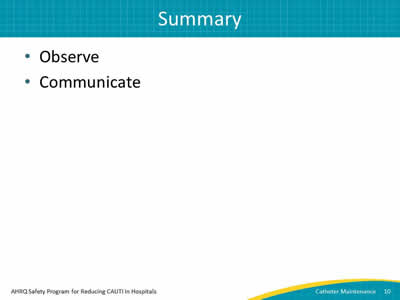
Say:
So, what did you learn in this module?
First, a major part of preventing CAUTIs in the ICU is being observant. Would you have noticed the transporter putting the urine catheter bag on a patient’s abdomen? What about using a securement device?
Second, communicate. In this scenario, the transporter didn’t understand what might happen because of wrong bag placement or because a securement device was not in place. If this happens where you work, take the time to have this difficult conversation, but do it outside the patient’s room. Keep in mind that this difficult conversation actually educates and empowers the transporter to be part of the efforts to prevent CAUTI.
Lastly, consider including ancillary personnel such as transporters and other members of the interprofessional team who care for patients with an indwelling urinary catheter in CAUTI prevention training.



